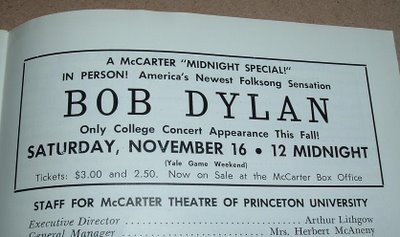 Or so said the 1963 advertisement I found over the weekend in a copy of Eugene O'Neill's, A Long Day's Journey into Night (Yale, 1956, sixth printing). The ad appeared in a playbill for O'Neill's play being performed at Princeton's McCarter Theatre that year. The playbill, which was laid in the O'Neill book, had a blurb on the rear cover about Dylan appearing later that fall, so I flipped through the dozen pages or so and found a larger ad announing America's newest folksong sensation making his only college appearance that fall. And shouldn't that be "America's newest folksinging or folksinger sensation?"
Or so said the 1963 advertisement I found over the weekend in a copy of Eugene O'Neill's, A Long Day's Journey into Night (Yale, 1956, sixth printing). The ad appeared in a playbill for O'Neill's play being performed at Princeton's McCarter Theatre that year. The playbill, which was laid in the O'Neill book, had a blurb on the rear cover about Dylan appearing later that fall, so I flipped through the dozen pages or so and found a larger ad announing America's newest folksong sensation making his only college appearance that fall. And shouldn't that be "America's newest folksinging or folksinger sensation?"  Grammatical correctness aside, as I flipped through the pages, I also found the star of the play, whose photo on the front cover I hadn't recognized: Olympia Dukakis. Aha! I thought she looked familiar. What else might be in this playbill? More plays that Ms. Dukakis was starring in, plus an ad for a famous Russian puppeteer, Sergei Obratsov. Quite a lot of celebrity packed into that little college playbill--a well-established "star" of puppet theater, plus two up-and-comers in their respective fields: Dukakis and Dylan.
Grammatical correctness aside, as I flipped through the pages, I also found the star of the play, whose photo on the front cover I hadn't recognized: Olympia Dukakis. Aha! I thought she looked familiar. What else might be in this playbill? More plays that Ms. Dukakis was starring in, plus an ad for a famous Russian puppeteer, Sergei Obratsov. Quite a lot of celebrity packed into that little college playbill--a well-established "star" of puppet theater, plus two up-and-comers in their respective fields: Dukakis and Dylan.  Trying to find some cosmic coincidence of fate for these two items being paired in the 1960s, one has to look no further than the play's 1912 character, Mary Tyrone (Dukakis) and her drug addiction (morphine). And it was drug addiction, or the drug culture and drug usage, that permeated and partially characterized the artistic, political, and philosophical counter-cultural movements of the 1960s.
Trying to find some cosmic coincidence of fate for these two items being paired in the 1960s, one has to look no further than the play's 1912 character, Mary Tyrone (Dukakis) and her drug addiction (morphine). And it was drug addiction, or the drug culture and drug usage, that permeated and partially characterized the artistic, political, and philosophical counter-cultural movements of the 1960s. The Freewheelin' Bob Dylan, a reluctant icon for his generation, had just recorded his second album. The seeds of his enormous success and cultural influence and the wave of counter-culture revolution were, at that time, just blowin' in the wind.
No comments:
Post a Comment